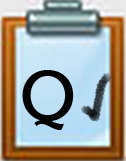QGS5 Google Slides: Advanced Features
Introduction
As you may have discovered, there are many different menus and tools on the Google Slides toolbar. This Quest will focus on more advanced features of formatting, animation, transitions, and management tools. You will be learning through the tutorials, trying them out, and then sharing what you have learned with others.
I Can Statements
- collaborate to create a presentation
- understand and be able to apply advanced of Google Slides
KEY VOCABULARY
Alignment: Alignment refers to how the text flows in relation to the page or table cell. The text may be aligned left, right, center, or justified (spacing is adjusted between words to be equally between right and left borders).
Animation: Animation refers to effects that can be applied to text or objects on the slide so that they show some type of movement.
Animation sequence: When animations are formatted to do an action automatically after, before, or simultaneously with another action.
Bullets (in formatting): Bullets refers to the graphical characters, numbers, or symbols docs that are used to identify a list of items.
Drop-shadow: A drop-shadow is a visual effect where it appears there is a shadow of the object or textbox to look three-dimensional.
Layout: Slide layouts contain formatting, positioning, and placeholders for all of the content that appears on a slide.
Reflection: Reflection is an effect that creates a mirror image or part of the image is a reflection of the other part.
Slide Management: Slide management is the duplication, deletion, moving the order, and skipping slides.
Speaker Notes: Speaker notes is a Google slide feature that is a text box located below the slide to enter text to remember talking points for a presentation.
Transition: Transition are animation-like effects that occur in Slide Show view when you move from one slide to the next during an on-screen presentation.
Vocabulary Game
Play the interactive Quizlet Game: Direct Link
Steps
1. Copy and use this Example Slide Presentation to copy to your own drive, and explore applying the different features. Tutorial videos are provided in the content boxes below for each feature.
2. Share any new tricks you have learned with classmates:
Some suggested options are:
- take screenshots with step-by-step illustrations and descriptions
- record the screen and explain what you discovered using a video tool (such as Screenpal (formerly Screencast-O-matic), Flip, Screencastify extension for Chrome)
- create an audio recording describing the feature and effect
- present live or through a virtual resource to your class
3. It's time to work with your partner or group on your presentation and apply some of the features you have learned about.
Demo: Hyperlinked Table of Contents and Quickly locate your presentations in your drive
This is a short video (1:30) demonstrating two actions:
- how to hyperlink the Table of Contents to other slides in the presentation
- how to quickly locate your presentations in your Google Drive space
Demo: Animations and Sequencing
This 4:10 minute video demonstrates how to create animations, and how to create a sequence of actions with different objects on the slide.
Demo: Text features including bullet symbols (emojis)
This video (2:06) demonstrates text features: bold, highlight, line spacing, alignment, and using custom characters or symbols (emoji) as bullets.
Demo: Drop Shadow, Reflection, Plus Slide Transitions
In this (4:10) video tutorial we demonstrate adding a drop shadow to text, and a reflection to an image. Adding transitions between slides is also part of this short video.
Demo: Slide Management (Layouts, Speaker Notes & Spelling Tool)
This (5:56) video has bookmarks that can be found along the play timeline as dark sections that show a mini image with the name of the section.
Duplicate Slide (0:35)
Delete Slide (0:48)
Skip Slide (01:00)
Moving Slides (01:44)
Grid View (02:11)
Slide Layout (02:40)
Speaker Notes (03:33)
Spelling Tool (04:41)
Last slide with animation (05:22)
Completing this Quest
- You have shared and/or demonstrated some new features learned
- You and your partner or group have applied some new features to your presentation.
- Shared your progress with the teacher.
The next Quest will explore options and tips for presenting your presentation. Make sure to review the I Can Statements before moving on to the last Quest in this series.
Check off this Quest on the 21t4s roadmap
Ready for Quest 11.QGS 6 Present & Publish
Additional Resources
Miscellaneous Tips
Last Step
Apply what you have learned and continue to work on your Group Presentation slide(s) and carefully consider which elements will support your topic best and look professional.
Here are some tips:
Text on the slide Bullet Points:
- Limit the number of bullet points on each slide to 3 or less
- Font Size: If your presentation is to be shown on a screen using a projector, make sure the font is large enough (24-30 point is recommended). If it will be viewed on a computer monitor or device, then
- Type of Font: Arial, Calibri, and Garamond, are recommended, and to avoid script and italic fonts. For titles you might choose a Serif or Sans Serif font
- Consistency: Settle on a consistent font for your group slide presentation
- Photos and Images When including pictures (photos or images) use proper citations to cite the source when there are copyright restrictions A link to a website about your slide content that you found in your research
Competencies & Standards
MITECS Michigan Integrated Technology Competencies for Students, and
1. Empowered Learner
a. Articulate and set personal learning goals, developing strategies leveraging technology to achieve them, and reflect on the learning process itself to improve learning outcomes
b. Build networks and customize their learning environments in ways that support the learning process
c. Use technology to seek feedback that informs and improves their practice and to demonstrate their learning in a variety of ways
d. Understand the fundamental concepts of technology operations, demonstrate the ability to choose, use and troubleshoot current technologies and are able to transfer their knowledge to explore emerging technologies
2. Digital Citizen
b. Engage in positive, safe, legal and ethical behavior when using technology, including social interactions online or when using networked devices
c. Demonstrate an understanding of and respect for the rights and obligations of using and sharing intellectual property
3. Knowledge Constructor
c. Curate information from digital resources using a variety of tools and methods to create collections of artifacts or solving authentic problems
6. Creative Communicator
a. Choose the appropriate platforms and tools for meeting the desired objectives of their creation or communication
b. Create original works or responsibly repurpose or remix digital resources into new creations
c. Communicate complex ideas clearly and effectively by creating or using a variety of digital objects such as visualizations, models or simulations
d. Publish or present content that customizes the message and medium for their intended audiences
7. Global Collaborator
a. Use digital tools to connect with learners from a variety of backgrounds and cultures
b. With guidance from an educator, students use technology tools to work with friends and with people outside their neighborhood, city and beyond
c. Contribute constructively to project teams, assuming various roles and responsibilities to work effectively toward a common goal
Websites and Documents
Websites
- Flip
- Google Help for Presentations
- Google Slides
- Screencastify Extension for Chrome
- Screenpal (formerly Screencast-o-Matic)
- Google Slide Transitions YouTube video (3.12 min)
21t4s Videos
- Introduction Video (1:00)
- Hyperlinked TOC and Locate Presentations Quickly (1:30)
- Animations and Sequencing (4:10)
- Text Features and Bullets as Emoji Symbols (2:06)
- Drop Shadow, Reflection, and Slide Transitions (4:10)
- Slide Management (Layouts, Speaker Notes, & Spelling Tool) 05:55
21t4s Documents & Quizzes




